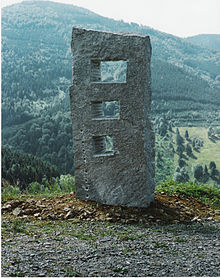Dieter Oehm
Dieter Oehm (* 1947 in Bad Hersfeld ) is a German sculptor and painter. He uses colored pencils for his drawings. He mainly makes his sculptures out of wood and stone.
Life
Oehm studied 1968/1969 at the Werkkunstschule Offenbach (today HfG). From 1969 to 1974 he studied sculpture at the Frankfurt Städelschule: sculpture with M. Croissant (master student), art theory with R. Jochims and graphics with Christian Kruck. In 1971 Oehm received the Städelschule's graphic arts award. The Arno Leißer Prize (1973) followed. He then completed a degree in education (diploma) at the Johann-Wolfgang v. Goethe University Frankfurt (from 1974 -76). Oehm lives and works in Bad Vilbel and Hohenlohe (BW). Oehm has been teaching plastic design and drawing at the State Drawing Academy in Hanau since 1976 . In 1987 he conducted a course as a guest lecturer at the HfG Offenbach. Oehm has been running the Sculpture Landscape project (near his studio) in Hohenlohe (Baden-Württemberg) since 1992.
Works
In more than 40 years, Dieter Oehm has created a comprehensive oeuvre in which the consistency of his creative work and the continuous juxtaposition of drawing and sculpture are striking. His sculptures are in the tradition of classical, constructive sculptures. The sculptures made of wood or stone in the room seem to consist of additively assembled elements. In fact, however, they are worked out subtractively from a single block. Constructed of mostly cubic forms, the sculptures form complex structures of materially defined areas and zones that remain free, which obey their own tectonics and are brought into a fragile, even unstable-seeming equilibrium. Towering rod and surface figures seem to defy gravity in a mysterious way. The artist uses all the possibilities of the material. The basic material (e.g. wood) contains structure of relationships due to its size and proportion, the permutational exploitation of which releases hidden potentials - and thus determines the work. Although Oehm uses all artistic freedoms in this process, this constructive approach largely rules out arbitrariness.
Works in public space
- 1974 -> Raumelement <, purchase of the state of Hesse, wooden sculpture, Bad Wildungen spa gardens
- 1976 -> Body Space <, acquisition of Helaba Frankfurt / Main, wood sculpture
- 1978 -> Stranded Stein <Bad Hersfeld, market square
- 1980 -> Survival <, Langen, Mühltal, sandstone sculpture
- 1981 -> Ruder <, Hanseatic City of Bremen, An der Weser, wooden sculpture
- 1984 -> Blicklust <, casting, tubular steel, basalt, plastic
- 1985 -> Moving Stone <, Wiesbaden, Chemical Research Institute of the State of Hesse, 1st Prize at the State Sculpture Competition, 3-part, shell limestone, installation,> Column room <wooden sculpture
- 1986 -> Fort-Da <, Bad Hersfeld, Abbey District, 2-part, marble sculpture
- 1987 -> Surface-Space-Element <, Karben, Vocational Training Center South Hesse, wood sculpture
- 1998 -> Ineditum <, Darmstadt, printing house Haußmann, wooden sculpture
- 1999 -> Genesis <, Neu-Anspach / Taunus, Catholic Church of St. Marien, mural pencil and colored pencil
- 2000 -> Raumelement <, Museum Goch, wooden sculpture
- 2002 -> Breakthrough <, Bad Vilbel, An der Wasserburg, 2-part stone sculpture, Elzach / Yach, competition prize for the international sculpture symposium,> Three stages of seeing <, granite sculpture
- 2003 -> Corpus Christi <, Neu-Anspach / Taunus, Catholic Church of St. Marien, sculpture, bronze
- 2004 -> Resurrection <, Neu-Anspach / Taunus, Catholic Church St. Marien, mural pencil and colored pencil
- 2004 -> Versteinerter Blick <, Hanau, Protestant Johanneskirche, marble sculpture
- 2005 -> Clavis <, Bad Vilbel, Wasserburg, wooden sculpture floating
- 2011 -> Prospectus Bipartitus <, Schwäbisch Hall, 2-part shell limestone sculpture
- 2011 -> Panta Rhei <, Goch, Nierswelle project, 2-part shell limestone sculpture
Solo exhibitions (selection)
- 1974 - Sculptures in the Palmengarten, Frankfurt / Main
- 1977 - Studio Berggemeinde, Frankfurt / Main
- 1978 - Art Association Friedberg; Abbey ruins; Large sculptures made of wood and stone, Bad Hersfeld
- 1979 - Upper Hessian Museum, Giessen
- 1982 - Dominican monastery, Frankfurt / Main, installation and sculptures
- 1988 - Museum Schloss Philippsruhe, Hanau
- 1993 - Museum Langen
- 1998 - Dominican monastery, Frankfurt / Main,> The gaze becomes the prey of pictures <, drawings; Juridicum JWG University Frankfurt / Main
- 1999 - Yellow House, Creuzburg> Punti Essentiali <; Art book first publication
- 1999–2000 - Museum Goch, retrospective
- 2000 - Museum in the Spital, Bad Hersfeld
- 2001 - Sculpture Cabinet / Freiburg
- 2002 -> Visual scores / sculptures <Dominican monastery, Frankfurt / Main
- 2008 - Kunsthalle Gießen, sculptures - drawings
- 2009 - Trier Art Association
- 2010 - Historisches Museum Hanau,> Corpus Inexhaustus II <sculptures; > In the face of the days <drawings
- 2010 - Hall of the Foundation for Concrete Art, Freiburg-Zähringen
- 2010 - Hall of the Foundation for Concrete Art, Freiburg,> Recognizable from One <(Visible out of One)
Web links
| personal data | |
|---|---|
| SURNAME | Oh, Dieter |
| BRIEF DESCRIPTION | German sculptor and painter |
| DATE OF BIRTH | 1947 |
| PLACE OF BIRTH | Bad Hersfeld |

